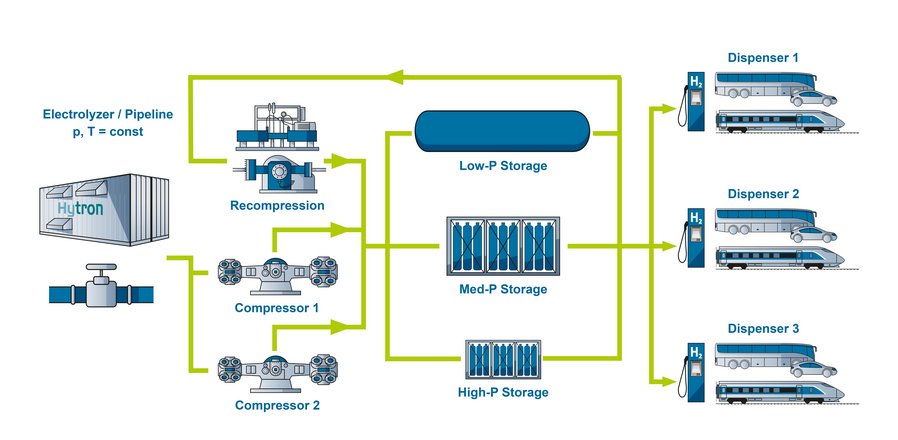
To meet the goals which were set in the global battle against global warming all sectors like industry, buildings and mobility must contribute with measures to defossilize their business. Rolling stock, even though already one of the most climate friendly means of transportation and mobility still has plenty of room for improvement when it comes to cutting CO2 emissions. One way is the extension of electrification by overhead lines in combination with renewable power sources, but the high infrastructure costs limit this to the main lines in the railroad network. Therefore, the share of diesel- powered units is still very high. In order to meet the climate protection goals they can be replaced with battery-, or, when more endurance is required, hydrogen fuel cell powered systems. Furthermore, rolling stock with its impressive hauling capabilities can also be used to transport hydrogen in form of a “rolling pipeline”.
Currently most HRS projects for railroads are focusing on refueling multiple units like the Alstom Coradia iLint or the Siemens Mireo Plus H. These models offer ranges of 600 – 1,000 km with a tank capacity of 150-200 kg of gaseous compressed hydrogen at around 350 bar. Typically, they consume 20 – 30 kg of H2 per 100 km. This means they must refuel once a day, ideally during the nighttime window when little or no passenger operation takes place.
NEUMAN & ESSER is currently supplying the compression systems for one of the biggest H2 train projects worldwide. 27 trains operating on four different lines in the Frankfurt Rhine-Main region need a reliable fueling infrastructure. For this project, surplus hydrogen is taken from a chemical plant and compressed from 6 bar to a discharge pressure of 550 bar. This is achieved by six 3-stage diaphragm compressors of NEUMAN & ESSER, delivering about 50 kg/h of H2 each. So, in total about 7 tons of hydrogen can be delivered per day, which already includes a reserve beyond these 27 trains.
Currently most HRS are supplied by trailers, which in turn are filled at a “mother station”. There hydrogen from a source like electrolysis is compressed and mostly also filled into buffer vessels and from there it flows via a valve manifold system into a trailer. These trailers can either be steel bottle or tube trailers or Multiple Element Gaseous Containers (MEGC) consisting of composite vessels arranged in a standard container frame. Depending on the systems around 300 – 1,500 kg of usable hydrogen can be transported per truck. These trailers are then connected to the HRS, the “daughter station” and the H2 flows from there into the vehicle tanks or the buffer vessels. Once the trailer is depleted to a certain level a compressor is used to empty them as far as technically reasonable.
For constant supply solutions typical inlet pressures are between 5 and 50 bar. Depending on that and the required discharge pressure, which in turn is depending on the vehicle tank pressure, single-, two- or three-stage compressors units are used. When only very low suction pressures are available a precompression piston compressor must be added to the configuration.

To allow for optimum compressor usage a buffer vessel system offering a pressure cascade of two to three pressure levels is reasonable for both types of supply. Here often a mix of conventional steel vessels for maximum 200-300 bar and stationery MEGCs for 500 to more than 600 bar are used. It is important to make sure that the regulations for storing H2 (e.g. Seveso Directive, BImSchG) are fulfilled.
For the connection of the vehicle tanks to the buffer vessels a dispensing unit being able to control the overflow from one pressure level in the buffer cascade into the tank is required. As the vehicle tank will heat up when being filled and the never exceed tank temperature is 85°C precooling/chilling to 0°C or even -20°C becomes a must if fast filling times of 10-20 minutes per train are needed. It is also reasonable to have at least two dispensers which can operate independently at site. Measuring the quality and the amount of the dispensed H2 is also an important feature included.
Apart from safety & control a condition monitoring system with remote access is helpful to ensure high plant availability. It is best combined with a maintenance agreement. (Semi-)Automizing the refueling process with a robot and having a data link between tank and fuel station is helpful to improve the fueling process. For the future the data connection and communication of the fuel station to the individual trains, even when they are running, is a good option to enhance planning quality. This will become more important when the number of different operators of H2 trains will increase. Our NEA|XPLORE platform has this capability expansion already included in its IoT-architecture.
All in all, it can be seen that hydrogen proves to be the ideal diesel substitute for rolling stock. The fueling technology, which is a scale-up of road vehicle HRSs and trailer fillers has already achieved a high degree of maturity and reliability. The next steps will be to roll out more and more of the H2-trains and fuel stations and to connect them via data communication for optimized availability and scheduling. The compressor industry is ready for defossilizating the rolling stock technology via hydrogen.